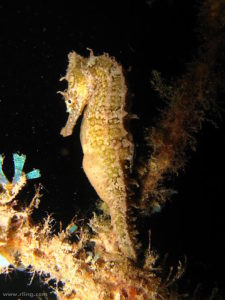VIDEO: The seahorse’s pouch is easy to spot in the above image of a White’s seahorse (also known as a New Holland seahorse). This species is endemic to coastal waters of Australia. The video of the male seahorse giving birth, on page 2 of this article, was taken off the coast of the Australian state of New South Wales.

Above photo attribution: By Richard Ling from NSW, Australia (White’s Seahorse) [CC BY-SA 2.0 (http://creativecommons.org/licenses/by-sa/2.0)], via Wikimedia Commons.
This seahorse is resting with his prehensile tail wound around a stationary seaweed.
Marine biologists from the University of British Columbia were lucky to witness a New Holland seahorse (Hippocampus whitei) giving birth in the waters off of Little Beach in Nelson Bay, New South Wales, in November 2015.
The New Holland seahorse, also known as the Sydney seahorse or the White’s seahorse, is an endemic Australian species of fish in the family Syngnathidae.
This species grows to about 8 inches (20 cm) in length and occurs in depths down to about 65 feet (25 m) in shallow, weedy, inshore areas, in seagrass beds, on sponges, and often under jetties on kelp holdfasts.
The reproduction of seahorses is extremely remarkable. Unlike most other animals, females deposit eggs into a pouch on the male’s abdomen. The males then fertilize, carry and nourish the developing embryos in a form of pregnancy.
In New Holland seahorse, the male fertilizes the eggs and cares for them for about three weeks, according to marine researchers from the Australian Museum.
The source article describes the “size” of the 100 to 250 fully formed young seahorses escaping from the incubation pouch to be about 1 centimeter. If the adult in the video is actually 8 inches (20 cm), or even smaller in size, we’re guessing the 1 centimeter is probably not counting the tail, as the babies who float away seem to be much longer than 1 centimeter. See what you think, when you watch the video on the next page.



